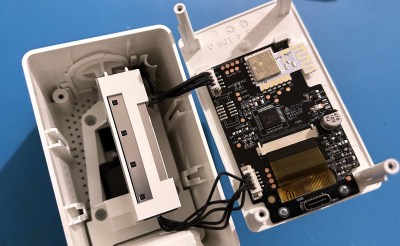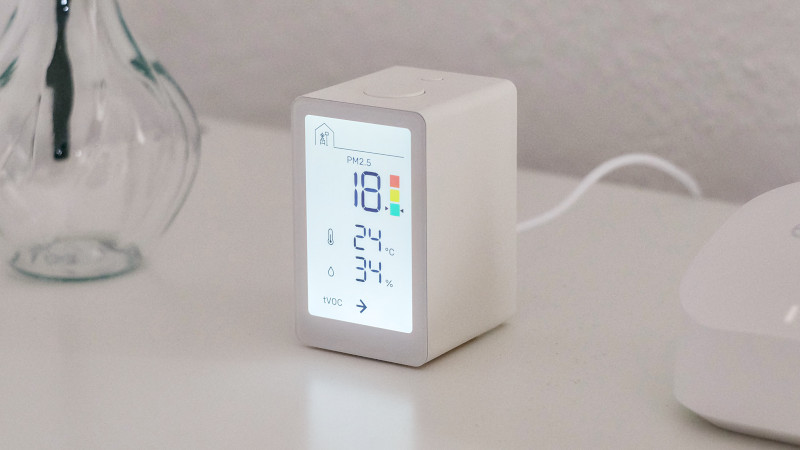Whether it’s because they’re concerned about worsening pollution or the now endemic variants of COVID-19, a whole lot of people have found themselves in the market for a home air quality monitor thee last couple of years. IKEA noted this trend awhile back, and released the VINDRIKTNING sensor to capitalize on the trend.
The device must have sold pretty well, because last month the Swedish flat-packer unveiled the considerably more capable (and more expensive) VINDSTYRKA. Now thanks to the efforts of [Oleksii Kutuzov] we’ve got a fantastic teardown of the new gadget, and some more information on the improvements IKEA made over its predecessor.
 Certainly the most obvious upgrade is the addition of an LCD readout that displays temperature, humidity, and how many particulates the device detected in the air. There’s even a “traffic light” colored indicator to show at a glance how bad your air supply is. The other big change is the addition of wireless, though unlike the WiFi hacks we saw for the VINDRIKTNING, this built-in capability uses Zigbee and is designed to plug into IKEA’s own home automation ecosystem.
Certainly the most obvious upgrade is the addition of an LCD readout that displays temperature, humidity, and how many particulates the device detected in the air. There’s even a “traffic light” colored indicator to show at a glance how bad your air supply is. The other big change is the addition of wireless, though unlike the WiFi hacks we saw for the VINDRIKTNING, this built-in capability uses Zigbee and is designed to plug into IKEA’s own home automation ecosystem.
Speaking of those hacks, a GitHub user by the name of [MaartenL] chimes in to say they’ve managed to hook an ESP32 up to test pads on the VINDSTYRKA motherboard, allowing the parasitic microcontroller to read the device’s sensors and report their data on the network over a service like MQTT, without impacting the sensor’s normal operations. This is how the first hacks on the older VINDRIKTNING were pulled off, so sounds like a promising start.
But even if you aren’t looking to modify the device from its original configuration (how did you find this website?), it seems pretty clear the VINDSTYRKA is a well-built piece of kit that will serve you and your family well. Which is more than what could be said for some of the cheapo environmental sensors flooding the market.
Thanks to [killergeek] for the tip.















This sensor is a normal Zigbee device and works without IKEA’s own home automation ecosystem. Naturally. It is already supported by Zigbee2MQTT. So there is no need to modify it to get the readings via MQTT.
Thank you.
Do you have more information on this? It would seem to go against what’s stated in the repo currently.
This page suggests it’s supported:
https://www.zigbee2mqtt.io/devices/E2112.html
That was my initial thought as well, but looking at the Github repo and Zigbee2MQTT page, it looks like this device does not natively expose the PM1, PM4, PM10, or VOC data available from the SEN54 sensor using Zigbee2MQTT, only the PM2.5, Temp and Humidity data. The DIRIGERA dump does look like it exposes the VOC data as well.
While PM1/4/10 data might not be useful in most usecases if you already have PM2.5 data, there are several applications where VOC measurements would be useful.
Either way, it does allow you to ‘unlock’ all the sensor data and use all the hardware features that are already present.
This is what is exposes:
payload ‘{“humidity”:50,”linkquality”:81,”pm25″:5,”temperature”:24,”voc_index”:10}’
Yes, but it runs… Linux? :)
Jokes apart: it runs Tasmota?
I have so many devices. Some ZigBees haven’t drivers inside the tiny Tasmota’s ZigBee2mqtt . Some Tuyas cannot be Tasmotized. Some EweLink haven’t a proper Rest Interface.
Tuya’s API requires a fee of USD 25,000.00 (yes, twenty-five thousand) per year. Or through a servile email they let you renew six months each time.
EweLink + IFTTT requires 10$/year + 70$/year for IFTTT, but not all commands are available and IFTTT doesn’t expand the few events available.
To collect all the data from different sensors and sending proper commands to every device is a nightmare because each device wants its gateway and its APIs to communicate.
Sounds like an opportunity for an open source equivalent.
There are plenty, but it doesn’t make building and supporting a commercial iot device free or even cheap.
Commercial devices use tuya because it’s *much* cheaper than the manufacturers designing and running their own iot hardware and online systems, so talking about their pricing in isolation is irrelevant.
But the big US companies (Google/Apple/etc) and Home Assistant have been working on the Matter automation standard, which is intended to allow open interoperability between devices/hubs/services regardless of who is making them, for both commercial and open-source systems.
A simple cloudless server, based on a Raspberry or something like that sets you free from cloud problems. There should be the double option: Tuya/Ewelink/Apple or cloudless. Anyway, just go on AliExpress and check how difficult is to find something outside the Tuya ecosystem.
Why would “a thing that runs on raspberry pi” be on aliexpress?
The thing you’re after is called Home Assistant, it’s been around for years. https://www.home-assistant.io/
Not really sure what the point of this gadget it cos if the particulates are high – what you going to do about it? 1. Open a window and hope no more smog comes in. 2. Clean off the mold growing on your ceiling 3. Throw the cat outside to fend for itself or 4. Get a fan assisted HEPA air filter with a particulate level display built in already.
BTW …. the answer is no. 4.
I was actually thinking of this just so I can keep my filter unplugged when I don’t need it. The cats enjoy turning it on high to annoy me
Ironically you are the problem and not the solution. We all need to stop creating excessive waste. Eg, zombie electrical devices and using consumables like filters that end up in landfill, and 7/8 the humans on the planet to help with the balance of sustainable life.
Not buy a wasteful filter device and collect the pollution into HEPA filters before dumping them in the waste where it’s most likely to be landfilled.
5. Lay off the Taco Bell and Indian food!
My usual comment: dust sensors need regular maintenance. Else they measure the dust collected in their airpath. Within 6 to 12 month the sensors become useless.
As most users seem to be fine with sensor results that look plausible (see the volatile organic compounds VOC bullshit) I strongly suggest to replace it with a motion sensor. More motion mean more dust, plausible result!
This might be true for LED based sensors that have been used in the previous generation, but the SEN54 is specified ro have have no more than 12.5% drift after being operated 10years 24/7 at 44ug/m^3, which is super high (section 4.6:https://sensirion.com/media/documents/B7AAA101/61653FB8/Sensirion_Particulate_Matter_AppNotes_Specification_Statement.pdf). The sensor will never see that concentration or you are living in a super unhealthy environment.
If you were talking about an unmodified VINDRIKTNING, I’d tend to agree with you, but aside from the display, the only reason anyone would pay 5x the price for the newer VINDSTYRKA unit is the native Zigbee connectivity, allowing easy integration into any Zigbee-based smart home ecosystem.
Throw one in your garage so that it automatically turns on the exhaust fan when temp, humidity, or VOCs get too high. Use it around the house to automate dumb standalone HEPA filter units that would otherwise constantly run. Use it to automate your central HVAC/ERV/HRV system based on per-room conditions. Put one in the kitchen so that your vent hood runs until the room drops below acceptable PM/VOC levels.
Well depending where you live(typo of hvac), I made multiple aiq stations that measure pm1/2.5/10, co2 etc… then I upgraded hvac filters to filtrete 2900+, added carbon filters to kitchen hood… my hvacs run the fan 24/7 to circulate the air regardless if heating or cooling is needed.
Pm in my house are 0 except when cooking, depending on the menu but it doesn’t go over 15ppm… only other situation when pm goes up is when i open the windows to get some fresh air.
Regarding co2 I open the window to ventilate daily and it keeps co2 in the expected range.
I’m planning on adding a duct for fresh air through the hvac controlled by aiq data so it opens the damper and pump some fresh air occasionally.
Is there a ZigBee enabled HEPA air purifier that can be turned on and off by this gadget?
Yeah, the more expensive ikea one has zigbee
From the datadump seems like it only sends PM2.5 data back to the hub, ignoring the 1/4/10.
Do you think there’s a reason behind?
Or maybe an update’s incoming to enable those…
mmm
I am waiting for someone to come out with an affordable CO2 sensor. A real one, not one of the fake ones that “senses” CO2 by measuring something else and guessing.
Well, the best you can currently get is the Sensirion SCD41, if I am not mistaken. But with 34.50$ (Digikey), affordable is rather “relative” here.
Looking into the wikipedia page[1] that might be a long wait.
I assume that we might see a price drop if the current situations (crazy war, crazy sickness, crazy everything) is over. So it might never happen.
1: https://en.wikipedia.org/wiki/Carbon_dioxide_sensor
Based on single qty DigiKey orders:
The Sensirion SEN54 in this IKEA unit is $29.92 ea, while a true photoacoustic CO2 sensor like the Sensirion SCD40 is $29.70 ea, ie cheaper than the SEN54.
They’re still double the price of something like an Sensirion SGP30 VOC/eCO2 sensor, but you’re only talking about a ~$15 delta per sensor.
Add an ESP8266/32 board, enclosure, and display, and you can put together a wireless, true CO2 sensor for about the same price as the IKEA.
Props to the engineers at Ikea for labeling the test points!
IKEA farms out this stuff. At least from looking at their other products
Info on how to connect via Tasmoto
https://github.com/trlafleur/Tasmota-VINDSTYRKA